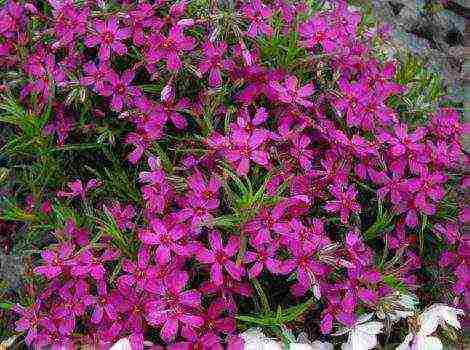Content
- 1 General description and application
- 2 Classification of varieties
- 3 The best daikon varieties by soil classification
- 4 Groups of daikon varieties by climatypes (seasonal dependence)
- 5 The best varieties of domestic breeders in terms of ripening
- 6 Video tips for growing daikon
- 7 How to grow daikon radish outdoors: planting and care
- 8 The best daikon varieties for the middle lane (with photo)
- 9 The healing properties of daikon
- 10 The root vegetable of health and longevity
- 11 Daikon as a botanical species
- 12 Classification by sowing time and climatic types
- 13 Classification by the shape and location of the root crop in the soil
- 14 Agricultural technology: from soil preparation to the first shoots
- 15 Daikon care during the growth of tops and roots
- 16 Sowing and harvesting dates by region
- 17 Reviews
- 18 Daikon varieties
This subspecies of radish is as frequent a guest on the Japanese table as potatoes in Russian. But, if radish in Russia has been eaten from time immemorial, then the daikon came to us from the east relatively recently. At the same time, he very quickly got used to it and has now surpassed his predecessor in popularity. And this is understandable. Unpretentious care, lack of bitter pungency and unpleasant pungent odor, so familiar to radish lovers, juiciness and noble appearance - all this disposes to make a choice in favor of a guest from the east.
General description and application
Outwardly, the vegetable usually looks like a large white carrot. However, the shape of the root crop varies by variety and can vary greatly, from nearly round to serpentine or spindle-like. Their length may not exceed a long-fruited radish, and may reach up to 2 meters. This is an annual, but it gives ripe seeds only for the second year. To choose the best variety of "Japanese radish" for planting on your site, first of all, you need to understand the mutual requirements: what we want from him and what he will demand from us.
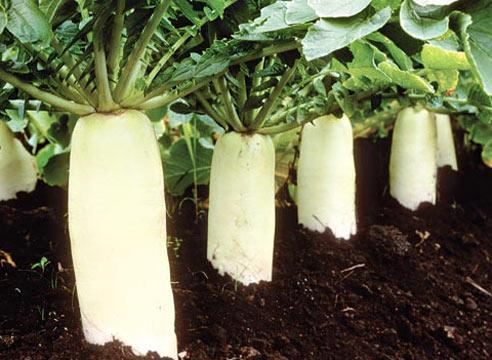
Ripening, depending on the species, lasts from 2 to 6 months. The yield reaches 10 kg from a garden bed of 1 sq. m (more often - 4-8 kg). Some species can be stored without loss of quality for up to six months, the average storage time is 2-3 months. It is eaten raw, salted, boiled, young leaves and cuttings go well for salad.
The daikon has a negative character trait - he loves to shoot. The extended arrow has a negative effect on the quality of the root, although not to the same extent as in radish. But long daylight hours are contraindicated for him. It is better to plant it either in early spring or in mid-late summer, depending on the climate of the region. In the middle lane, the best time is July, in the more southern regions - August. During these periods, it gives the most significant yield.
Classification of varieties
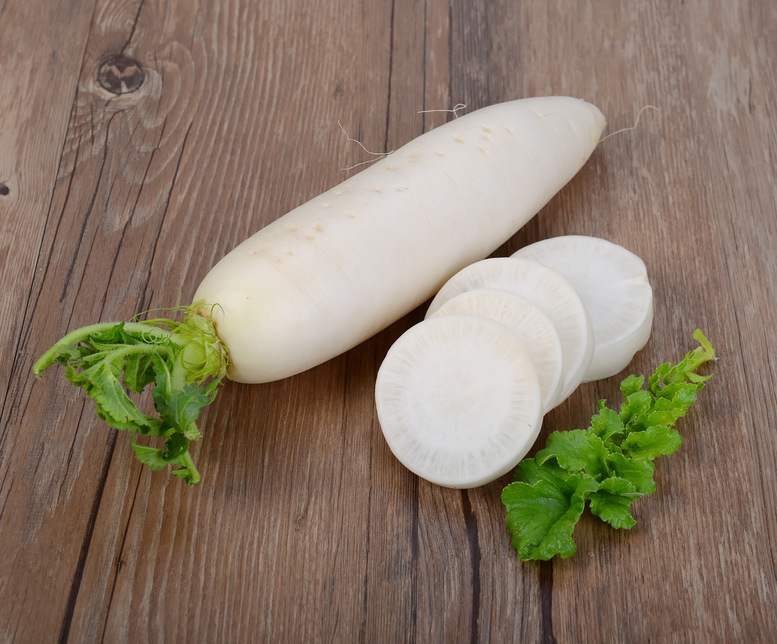
There are several types of classification of this culture:
- Depending on the depth of the roots in the ground. Some are almost completely immersed in it, while others are half, a third, or even a quarter.
- By the duration of the growing season and, accordingly, the timing of harvesting.
- Depending on the characteristics of the soil. It should be noted that in relation to the soil, this root crop is an ascetic. Some groups can even be grown on clay.
- By the shape of the roots and their size.
Digging the beds for "tall" varieties is often difficult because of their great depth. But solid ground stops the growth of root crops, therefore, on clay, loamy and other loose soils, experienced gardeners sometimes use a drill for planting.
The best daikon varieties by soil classification
Minovase - This is a large group of early high-yielding species that produce root crops with snow-white, juicy, weakly pungent pulp. The shape is elongated-cylindrical, in the middle lane it grows up to half a meter long. High degree of crop safety. Deepening - up to 3/4 of the length. It tolerates drought and hot summer well, ripens in 60 days.
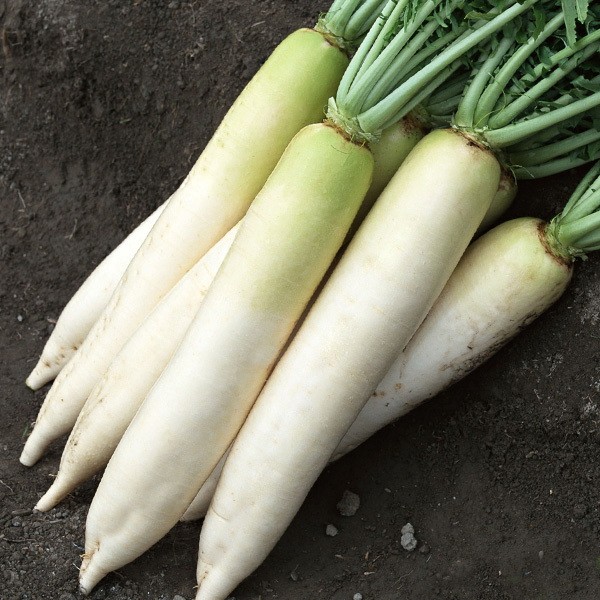
Ninengo - cylindrical or cone-shaped elongated fruits are completely submerged in the ground. Loves light soils, but is not capricious in this regard, resistant to cold snaps, grows up to 60 cm in 70-75 growing days.
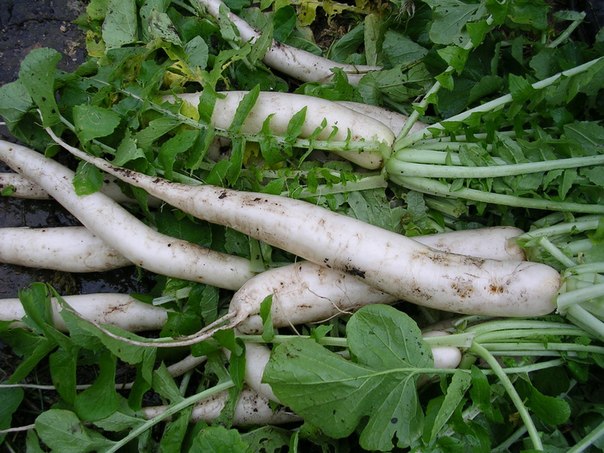
Elephant fang - the most widespread selection hybrid of the Chinese model with the Tashanhong radish in Russia. The elongated cylindrical white root vegetable has a light green pigmentation, grows up to 18-22 cm. It is 2/3 of its length above the surface. Has a juicy, sweet-spicy taste. Adapted for summer-autumn ripening, during this period it is resistant to flowering. When grown in northern latitudes (above 55 ° N), it is not suitable for spring sowing, because begins to shoot arrows and bloom, bypassing the fruiting phase.
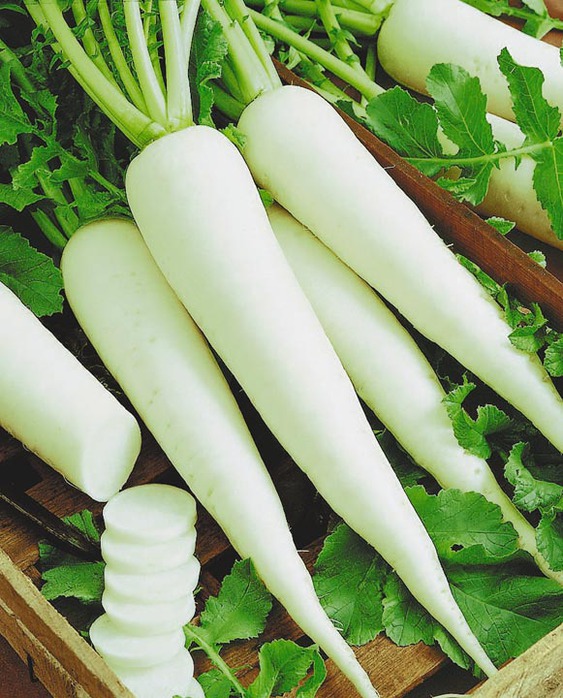
Nerima - bears fruit readily and well on loose, light soils. Ripens for a relatively long time, 70-100 calendar days. Root crops are smooth greenish, up to 60-70 cm in length, 2/3 submerged in the ground.
They are good fresh and salted.
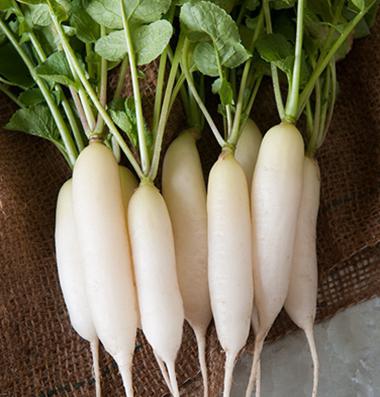
Miyashige - unpretentious to the soil, but shows the best yield on loam. Root crops of medium length, cylindrical shape, light green color. Ripens in 60-80 days. It can be used in any form, it is well suited for salting, but the spicy taste of dishes with the addition of boiled Miyashige is especially worth noting.

Shiroagari - varieties specially bred for cultivation in heavy soils. Small in length, up to 30 cm, this root is immersed in them only by a third or even a quarter, which allows you to get a good harvest on a poor fertile layer.
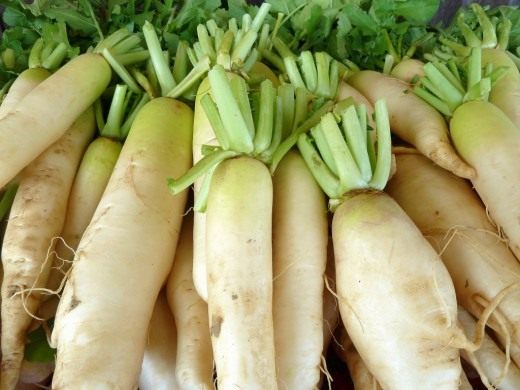
Shogoin - another small group for cultivation on heavy soils. It is preferable to eat fresh, salads. The vegetative period is 70-100 days.
Kameido - loves sandstones and light soil compounds. It goes deep into 2/3. Small in size, only up to 15 cm in length and 5 cm in diameter, conical in shape, with a slight pleasant sharpness. They are distinguished by especially juicy cuttings and foliage, which are good for seasonal salads.
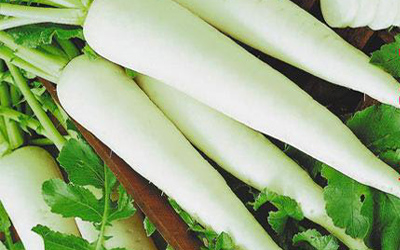
Groups of daikon varieties by climatypes (seasonal dependence)
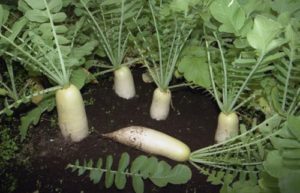 Haru (spring) - all varieties of this group have increased resistance to stalking and are suitable for year-round cultivation (in the presence of appropriate climatic conditions), including for early spring sowing. Therefore, they are of particular interest for mid-latitude gardeners. Planted in early spring, they make it possible to harvest in late May or early June. After that, you can repeat the planting and harvest another crop in August-September. In regions with a warm climate, a third sowing in winter is possible.
Haru (spring) - all varieties of this group have increased resistance to stalking and are suitable for year-round cultivation (in the presence of appropriate climatic conditions), including for early spring sowing. Therefore, they are of particular interest for mid-latitude gardeners. Planted in early spring, they make it possible to harvest in late May or early June. After that, you can repeat the planting and harvest another crop in August-September. In regions with a warm climate, a third sowing in winter is possible.
Hatsu (summer) - early ripening. You can dig up root crops after 50-55 days. It is sown in the "daikon off-season", in late spring or early summer. It is a salad-type vegetable that is resistant to hot weather.
Aki (autumn) - sowing of vegetables of this group is carried out in mid-late August (late and mid-late varieties). These include such well-known varieties as Shiroagari, Shigoin, Nerima, Miyasinge. They differ from their summer counterparts in yield and impressive sizes.
Fuyu (winter) - a very small group and little demanded in the conditions of the Russian climate, suitable for cultivation only in the southern warm regions, where frosts are excluded.
Daikon loves empty lands and is ideal for sowing after harvesting early crops - onions, radishes, lettuce, various greens.
The best varieties of domestic breeders in terms of ripening
Early ripening
A group of early maturing vegetables with a growing season of 40 to 50 days.
- Sasha - cold-resistant variety with a fruit root length of 6-12 cm and its weight up to 400g. A delicate white pulp with excellent taste ripens under the thin skin.
- Prince of danish - fruits of red "radish" color, juicy and very delicate in taste.
- Snow White - has good storage stability (up to 5 months). Under the light green skin, there is a snow-white flesh with a thin speck.
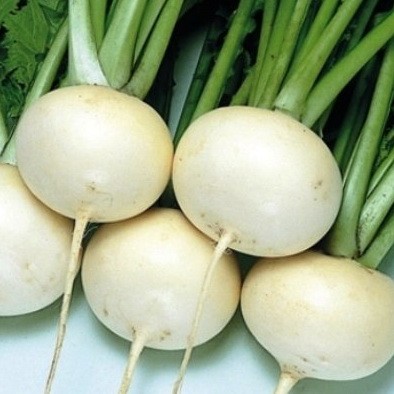
Mid-season
Ripening in 60-80 days.
- The Dragon - a cylindrical vegetable growing to a mass of 1 kg and up to 60 cm long. The taste is slightly sweet, pleasant, goes well with other ingredients.
- Dubinushka - slightly shorter than the previous grade, but gaining weight up to 1.2 kg. Has a fresh, pleasant taste without pungency.
- The emperor - resistant to cruciferous flea beetles, many diseases and flowers. Outwardly, it resembles an ice icicle. The pulp is soft, with a sweetish aftertaste.
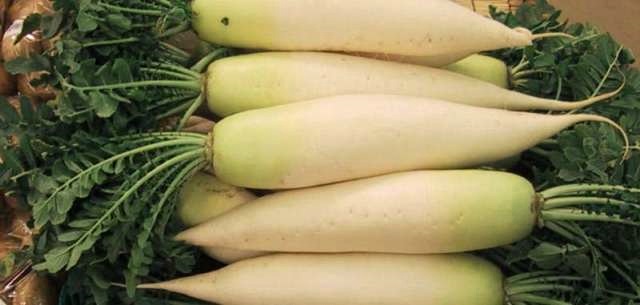
Late ripening
Slow ripening vegetables, "phlegmatic". Late ripening after 90-200 days complicates their cultivation in the middle lane. But these root crops are record holders in size.
- Japanese long - practically does not shoot arrows, gives a very high yield, the weight of one root can reach 3 kg. The taste is moderately spicy, it can be stored for a long time.
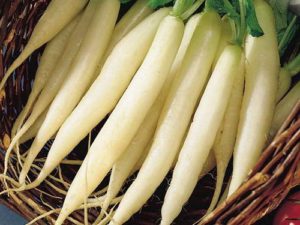 A well-chosen daikon variety is already half the success. It is unpretentious to care for if the growing conditions correspond to the selected species. "Japanese radish" is good for health, it is one of the few vegetable crops that help restore the liver and dissolve kidney stones. It is recommended to eat it for the elderly. Suffice it to recall that the Japanese allot one tenth of their precious land for sowing daikon. And the Japanese don't just do anything!
A well-chosen daikon variety is already half the success. It is unpretentious to care for if the growing conditions correspond to the selected species. "Japanese radish" is good for health, it is one of the few vegetable crops that help restore the liver and dissolve kidney stones. It is recommended to eat it for the elderly. Suffice it to recall that the Japanese allot one tenth of their precious land for sowing daikon. And the Japanese don't just do anything!
Video tips for growing daikon
How to grow daikon radish outdoors: planting and care
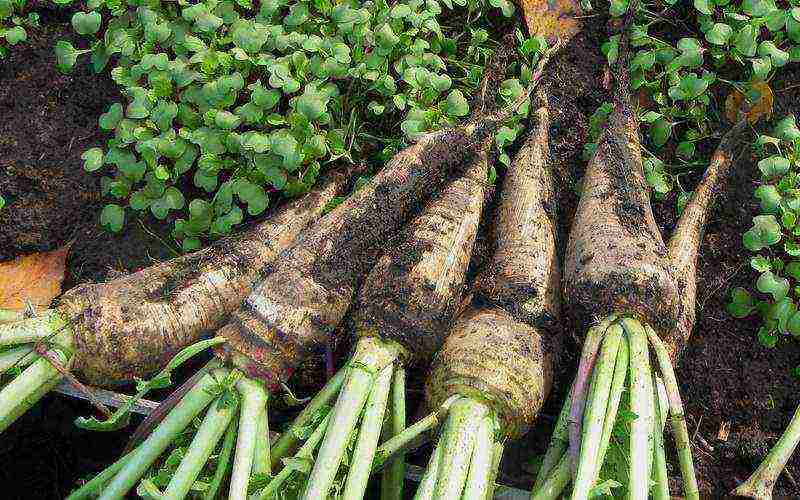
Radish daikon in the photo
Daikon is a promising new vegetable crop. His homeland is Japan. This is not a radish or a radish, although it is closely related, but still a special culture.
Daikon, unlike its relatives, has completely different taste qualities. There is no pungency and bitterness in it, the specific smell inherent in radish. Daikon fruits are more juicy and tender. This crop gives a high yield of root crops - up to 10 kg per 1 m2 - and has a good keeping quality (2-3 months without significant loss in quality).
Care when growing daikon in the open field is not difficult, because it is a rather unpretentious plant, it can be cultivated even on heavy clay soils. However, high yields of better quality root crops are obtained on light, fertile soils. The same soils are most suitable from the point of view of harvesting, especially for varieties with a root crop deeply embedded in the soil. Before planting a daikon in open ground, the soil for this culture should be well filled with organic fertilizers - compost and humus.
Growing and caring for daikon radish is done in the same way as for turnips. Seeds are sown to a depth of 3-5 cm in two rows on beds with a distance between rows of 60-70 cm, and between plants in a row - 20-25 cm. Seedlings will appear on the 5-7th day.
In the future, leaving is reduced to weeding, loosening and watering, protection from cruciferous fleas.
Top dressing when growing daikon in the open field on well-fertilized soils is not done; if necessary, it is timed to the phase of 1-2 true leaves (after thinning).
Daikon loves fertile and deeply cultivated soil, because in a short time (40-65 days) it increases the mass of the root crop up to 3 kg, sometimes up to 50 cm long.
The last summer date for planting daikon radish is early August.True, in this case, the root crops do not have time to reach a significant size, which reduces the yield.
The crop is harvested after 40-70 days, depending on the variety, the harvest is carried out in dry weather. On light soils, the roots are pulled out by the tops, and on heavy soils, they are undermined with a shovel so as not to break the long juicy roots. Store the vegetable in plastic bags or sandwiched in boxes. The daikon is well preserved in the basement and in the refrigerator at temperatures from 0 to + 5 ° C.
The best daikon varieties for the middle lane (with photo)
Our most popular varieties are summer sowing (from mid to late July), although there is the Sasha variety, which yields a harvest even when sown in spring.
The best daikon varieties for summer sowing are:
"Minovase" - super-yielding, mid-season variety, from germination to technical ripeness - 50-60 days. Root crops are white, cylindrical, up to 45 cm long, 3/4 buried in the soil. The pulp is juicy and crispy. Used fresh.
Miyashige - This variety has a smooth, thin skin. Root weight 100-140 g. Resistant to flowering, cold-resistant.
"Pink Shine Misato" - a variety with leveled, round, white roots with a diameter of 10 cm. Delicate, juicy, bright pink pulp is a decoration for any table.
"Red Samurai" F1 - a new unique early ripening hybrid that gives an excellent yield of cylindrical root crops 15-35 cm long and 7-8 cm in diameter, weighing up to 5 kg. The juicy and tender pulp of these root vegetables is much more tender than that of many radishes. Unlike radish, daikon roots, even flowering ones with an arrow, remain juicy and retain a good taste: there is no significant lignification of tissues.
"Dubinushka" - mid-season variety, from germination to harvesting of root crops - 56-63 days. Root crops are white, with a yellowish-green head, cylindrical, up to 40 cm long, weighing 0.7-1.5 kg. This daikon variety, popular in the middle lane, has a white, juicy flesh. Root vegetables are well kept.
"The Dragon" - mid-ripening variety (from germination to technical maturity 65-70 days) for growing in open and protected ground. The root crop is smooth, white, cylindrical with a conical escape, weighing 0.9-1.0 kg, 30-60 cm long, immersed in the soil by 1 / 3-1 / 2 of the length. The pulp is very juicy, tender, white, sweetish refreshing taste.
"Snow White" - early ripening variety for spring greenhouses and open ground (spring and summer-autumn culture). Resistant to flowers.
"Russian size" F1 - the earliest and largest-fruited daikon hybrid for summer sowing in temperate climates. After planting, with proper care, the daikon of this variety is ready for harvesting already 45 days after germination. Reaches 60 cm in length and 12 cm in diameter. Root crops are cylindrical, slightly running down to the tip, with a white smooth surface.
As you can see in the photo, this daikon variety has cylindrical and blunt-conical roots, white, with a light green head:
The pulp is juicy, with a mild taste. Productivity 5-8 kg / m2. In winter, it is stored in the sand for 4-5 months.
The healing properties of daikon
Unlike radishes, daikon root vegetables can be eaten not only fresh, but also boiled and salted.
Daikon helps to eliminate cholesterol from the body. The bactericidal properties of daikon are also known.
Young daikon leaves are also used for food, in which the content of vitamin C is even higher than in root crops, and amounts to 44 mg per 100 g of leaf mass. In addition, they contain beta-carotene, vitamins B1, B2, PP, E. Daikon is consumed for colds, to normalize intestinal activity, to strengthen hair. Root vegetables are used in many cuisines of the peoples of the world: in Japanese, and in Chinese, and in Vietnamese, and in Tibetan.
Knowing how to grow a daikon, you can provide your family with an environmentally friendly harvest. The selective ability of this crop to remove nutrients from the soil is truly unique.Root crops do not accumulate heavy metals (zinc, lead), radionucleides. Daikon, like radishes and radishes, contains a lot of potassium salts, which remove excess water from the body, and calcium, fiber, pectin substances, vitamin C and enzymes that promote digestion. It also has healing properties due to the content of glycosides, phytoncides and specific protein substances that inhibit the growth of bacteria. Root crops of this culture contain active enzymes that aid in the digestion of starchy foods.
Of all the vegetable plants, only radish, daikon and horseradish are able to cleanse the liver and kidneys, including dissolving stones. However, radish and horseradish contain too many rare (mustard) oils, which give the taste of these vegetables pungency, bitterness and stimulating the heart. Daikon is another matter. It does not have a dramatic side effect, since it practically does not contain those oils.
Daikon is a very ancient culture. The first mentions of him in the epic books of the Kojiki date back to the Yayoi period in Japanese culture, spanning the period from 300 BC. NS. up to 300 AD NS. This era marked the beginning of paddy rice cultivation and the consumption of wild-growing sweet radish on the islands.
The root vegetable of health and longevity
Translated from Japanese, "daikon" means "big root". It was bred by the Japanese from the Chinese lob radish. Then the vegetable settled on the private plantations of the peasants. Daikon was made a symbol of health, strength and well-being. Dancing with radish roots has been introduced into the culture of the country and even its free distribution at many public events in the fall season.
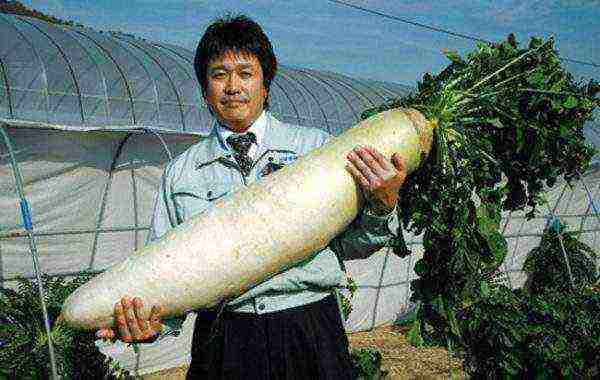
A 1.5 meter size for a daikon is not uncommon in Japan
But the advancement of the vegetable to the west was difficult. It took almost 20 centuries for the sweet radish to finally appear on the tables of Europeans. As a result, the unusual root vegetable was tasted and appreciated. Similar to a radish, but, unlike it, the sweet-tasting vegetable lent itself so well to selection, genetic modification and hybridization that by the first decade of the 21st century there were already about 500 daikon varieties. They differed from each other both in fiber density, and in the degree of piquancy, and in the brightness of taste, but especially in shape: there were simple balls, and serpentine arrows, and spindle-shaped spirals, and icicles of an unmatched milky-white color.
But all varieties were united by one essential quality - the absence of pungent mustard oils, which stimulate the heart muscle and are characteristic of radishes and radishes. Daikon, as it turned out, surpassed its relatives not only in taste, but also in the content of trace elements that inhibit the growth of pathogenic intestinal microflora and have a beneficial effect on the functioning of the liver and kidneys.
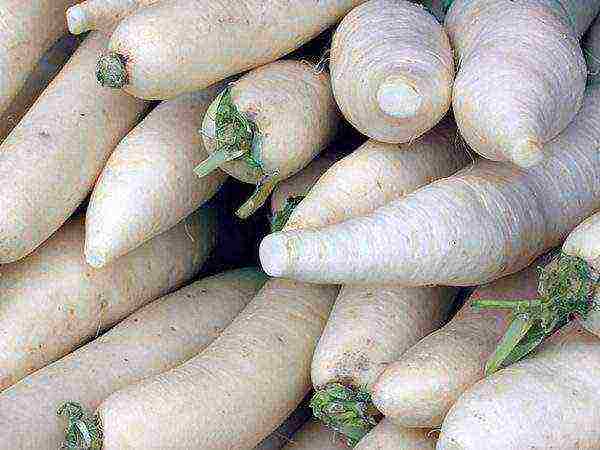
Daikon - a treasure trove of vitamins and minerals
Daikon as a botanical species
Daikon is a biennial or annual plant. It depends on the variety and the growing region. A strong rosette of dissected leaves that grows in the first three weeks after germination creates the potential for the formation of a future powerful root crop. Depending on the variety, it can vary from 500 g to 5 kg. Some champion specimens reach 20 kg and more. The root is characterized by excellent keeping quality, sweet taste and high trace element content.
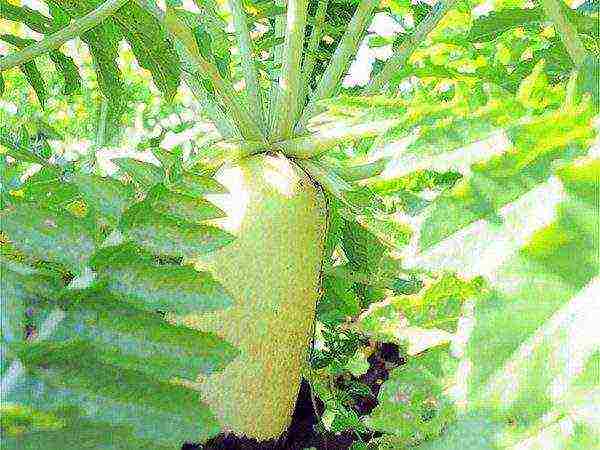
The branched green rosette promotes the formation of a healthy root crop
In terms of temperature, the plant is cold-resistant. Its seeds and seedlings can easily survive short-term light frosts down to -3 ° C. However, at prolonged negative temperatures, the daikon stops growing, loses its immunity and dies. He does not tolerate heat above +27 oC. The optimal temperature regime for the growth of foliage and root crops is considered to be the range from +11 to +26 oC. Drought also has a detrimental effect on the vegetable - it can lead to a curvature of the root of the fruit and bitterness in the taste.Extra moisture in the soil is not needed either - it contributes to the cracking of the fruit and the appearance of a bunch of diseases. Therefore, maintaining the temperature and the desired humidity level for the daikon are considered the main agricultural techniques.

Maintaining the right temperature and humidity is an important condition for the formation of a root crop
Classification by sowing time and climatic types
Since the plant is native to the Japanese islands, where the maritime climate, short off-seasons and mild changes of the seasons created their own rules for its cultivation, it is necessary to clearly understand its vegetative characteristics.
Daikon grows and pours during the phases of decreasing daylight hours and goes into the arrow if the length of natural daylight hours exceeds 12-13 hours - that is why it is important to calculate the timing of sowing seeds so that the stage of filling the root crop falls on the period of the decreasing day.
In other words, when choosing the timing of sowing daikon varieties on a garden bed, it is necessary to take into account the climatic duration of sunlight. There are 4 types of daikon:
- Haru, or spring views. Daikons of this group are planted in the ground in early spring with a view to harvesting in the last decade of May or the first decade of June. Summer sowing of seeds of the Haru group in July - August is also possible, especially in temperate regions. In Russia, these are areas of middle latitudes, which include the Moscow region, the Volga region, the Chernozem region, as well as the North-West, the Urals, Altai, Western and Eastern Siberia, Sakhalin, partly the Far East - that is, those regions where by the end of May the land completely moves away from the snow cover and warms up to at least +3 oC.
- Hatsu, or summer views. These varieties of daikons are early maturing, which are sown in early summer and must be dug out after 50 days. Hatsu varieties are generally resistant to summer heat and shooting. Such can grow in a hot zone, in the conditions of Krasnodar, Stavropol, Ukraine.
- Aki, or autumn views. It is recommended to start sowing seeds of this group from mid-August in southern latitudes or, adjusted for cold climatic conditions in most regions of Russia, from the second half of July. Harvesting begins in late September - early October. In some regions, ripening occurs even in November. The autumn daikon in size and juiciness can greatly exceed its summer relatives. Therefore, Aki varieties are considered the most acceptable for cultivation in central Russia and beyond the Urals. Moreover, they fully fit into the “concept of a short day” if sown after the summer solstice.
- Fuyu, or winter views. This group of daikons is considered ineffective for most regions of Russia. Only in warm climatic conditions, where there are no soil frosts, can we expect a harvest from it. Therefore, Russian breeders do not actually develop this group and do not recommend it for sowing.
Photo Gallery: Variety of Daikon Root Vegetables
Classification by the shape and location of the root crop in the soil
After deciding on the type of daikon according to the timing of sowing seeds, it is necessary to select a variety for the density and composition of the soil in the garden. To do this, you need to understand seven more groups of daikon, delving into their characteristics.
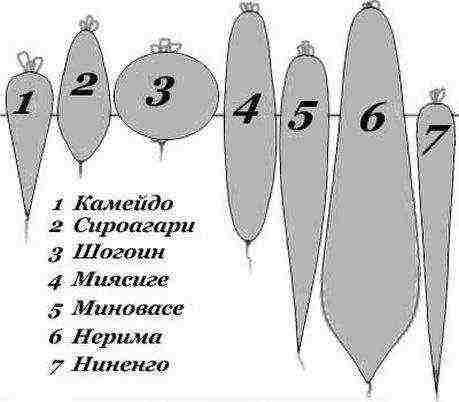
According to the shape of the fruit and the depth of occurrence in the soil, seven types of daikon are distinguished.
Kameido
Daikons of this group take root well and bear fruit on sandy soils. The roots themselves are round-conical and small in size: 15–17 cm in length and 5–6 cm in diameter. One third of the fruit does not sink into the ground, but grows on the surface of the soil. Not only root crops are suitable for consumption, but also leaves. This group includes Kameido, Ice spring, Okura cross varieties.
Shiroagari
These varieties are intended for cultivation in heavy clay soils. Cylindrical root crops are buried in the ground only by a third. To break through compacted soil, they have a thickening in the lower part of the root crop. A length of 30 cm is considered normal for them.The growing season is 60 days. This group includes: Tsukushi Spring Cross, Baseball, Nightingale the Robber.
Image Gallery: Shiroagari Daikon Group
Shogoin
Shogoin were also bred to grow on heavy clay soils with a little immersion in it. Root crops are relatively small: up to 20 cm in length. The shape is round-flat. The ripening period is up to 100 days. Famous representatives of the group, which have become widespread in Russia, are the varieties Sasha, Snow White, White Sun and Pink Shine, which has a pleasant pink tint on the cut.
Photo gallery: Shogoin daikon group
Miyashige
They love the soil fertilized with humus. But the roots themselves are not considered heroic: they grow up to 60 cm. They go deep into the ground exactly half their size. The vegetative ripening period is from 60 to 80 days. The brightest representatives of the group are considered to be the Fang of the Elephant, Dubinushka, and Caesar varieties.
Image Gallery: Miyashige Daikon Group
Minovase
This is the largest group of daikons. Root crops have a cylindrical shape, reach a length of 50-60 cm, a girth of 9-10 cm. They have a slight pungency in taste. The fruit goes three-quarters underground. Ripening period - from 45 days. Minovase tolerate elevated temperatures well. This group includes varieties Big bull, Russian size, Dragon.
Nerima
This group has a pear-shaped fruit. A pleasant milky white color, smooth, even structure, high yield are the lures that attract gardeners and buyers. Root crops protrude from the soil only by one third of their length, which can reach 20–25 cm. The ripening period is up to 100 days. The classic varieties of the group are White jam, Green Bogatyr, Nerima, Takuan-zuke.
Ninengo
It is characterized by an elongated conical root crop that completely sinks into the soil. The length, as a rule, does not exceed 60 cm, the girth is 6–7 cm. The group is perfectly adapted to endure spring and autumn frosts. There is also an increased resistance to shooting. The fruits ripen in 70–75 days. Typical representatives are Dragon's Tooth, Omni, Japanese Long, Tokinashi and Samurai, whose color smoothly changes from green at the base to white at the tip.
Photo gallery: Ninengo daikon group
Agricultural technology: from soil preparation to the first shoots
Daikon is an unpretentious culture and can grow on any type of soil, except for very acidic ones. But this does not mean that, having sowed the seeds, you can forget about them. There are certain agricultural techniques for planting and caring for daikons. And you need to start with preparing the soil.
Soil preparation
A bed for a daikon must be dug to a depth greater than a shovel bayonet: in the fall - for spring sowing, in the spring - for July or August sowing. In Japan, the best daikon is obtained on ridges of volcanic origin, which are very loose to a depth of 40 cm. Such looseness should be striven for in the conditions of Russia.
A large amount of humus or compost is introduced into the dug soil, which will help aerate the soil. Phosphorus-potassium fertilizers will also be useful for the formation of healthy foliage and root crops. Deoxidizers must be added to acidic soil: wood ash or dolomite flour.

Deep digging of the soil is required under the daikon, otherwise the root crop will grow curved
Daikon grows well on land after onions, garlic, salads, dill, potatoes, cucumbers, and legumes. You should not plant it on soils where related crops previously grew: cabbage, radish, radish.
Seed preparation
In order to prevent and protect the future plant from diseases inherent in cruciferous crops, it is recommended to pre-treat the seed. An effective method among agronomists is considered to be an option without the use of chemicals. For example, hardening with a contrast shower:
- We keep the seeds in a container for 20 minutes, first with moderately hot (45–46 ° C), then in ice (0–3 ° C) water.
- After the hardening procedure, we place the seeds in the vegetable compartment of the refrigerator and keep them there for 24 hours before sowing.
Sowing
Immediately before sowing, the prepared and fertilized bed is harrowed in advance, removing the germinated weeds. Sowing is carried out in grooves in one or two rows, located at a distance of 50 cm from each other. The seeding depth is 3-4 cm. Some gardeners prefer nests to rows. With this method, it is important to leave enough space between the nests, otherwise the roots will interfere with each other during growth, and this will affect the yield. The choice of seeding pattern depends on personal preference and the configuration of the beds.
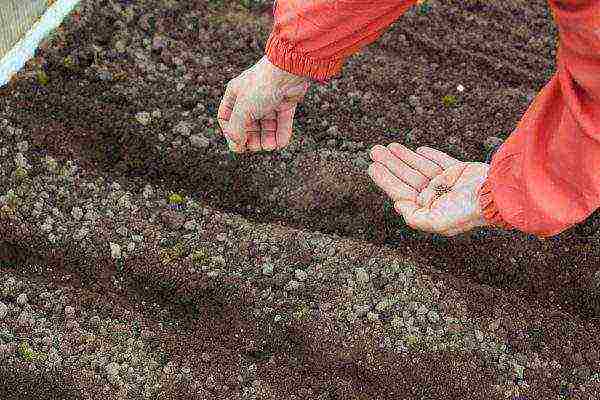
Before sowing, compost or humus is introduced into the grooves
The holes or rows are then sprinkled with earth and tamped. After that, it is advisable to cover the sowing site with wood chips - its rough surface will scare off slugs and flea beetles.
Thinning
The daikon rises on the 5-7th day. When the first and second true leaves appear, thinning is necessary. If a nesting scheme was chosen, then only one strong plant is left in one outlet, the rest are either removed completely, or transplanted to a separately formed bed. If sowing was carried out in rows, then when thinning between the shoots, a distance of 30–35 cm is reserved.
Daikon care during the growth of tops and roots
After each seedling has received its patch of land, they can be left alone for a while, just watching the development. If this is a spring sowing, then the precipitation during this period should be enough for the normal development of the roots. If sown in summer, it is necessary to control soil moisture and water the seedlings if there is a lack of moisture. Otherwise, the roots may crack and lose not only their shape, but also their taste.
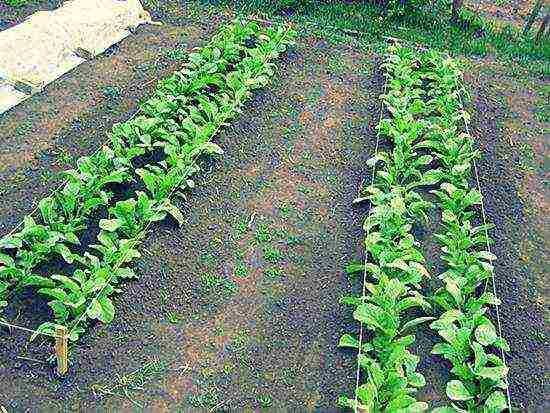
The better the daikon gains green mass, the healthier the root crop.
Top dressing and hilling during the period of root crop growth
Feeding the daikon at the stage of green crown formation is usually not required. However, if some unripeness or lethargy of the tops is obvious, then any complex universal fertilizer for vegetables will help out.
After the plants take root and get strong enough, the increased growth of the root crop begins. Top dressing during this period is possible, but again, depending on the physical condition of the plant. Potassium monophosphate at the rate of 1 tbsp. a spoonful in a bucket of water will feed the plant perfectly. Hilling is a mandatory manipulation at this stage. If the root crop is pulled out of the soil too much, then it runs the risk of acquiring bitterness in taste. Hilling will help keep the fruit fresh, juicy and firm.
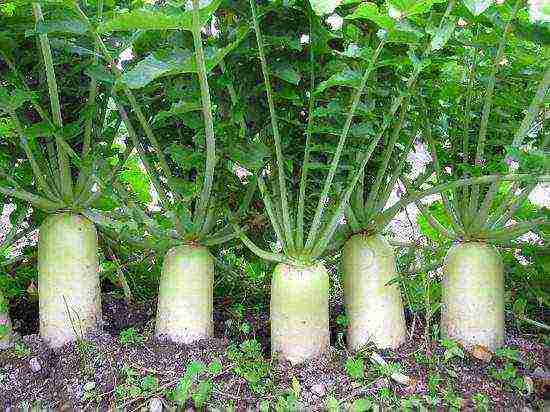
Hilling at the stage of a grown root crop is necessary to preserve its freshness, juiciness and density
With the correct sowing timing, the likelihood of flower arrows formation is minimized.
Pest and disease control
Among the diseases inherent in cruciferous plants, first of all, mucous bacteriosis is distinguished. When it is damaged, the foliage settles, and the root crop stops its development and softens. If you get it to the surface, then there will be a changed color (from white to gray-dark) and spots of rot on the top layer of the rind.
Other possible diseases of daikon: black leg, vascular bacteriosis, keela, felt disease. Treating affected plants is difficult and not always effective. But you can try the fungicidal preparations Binoram and Planriz.
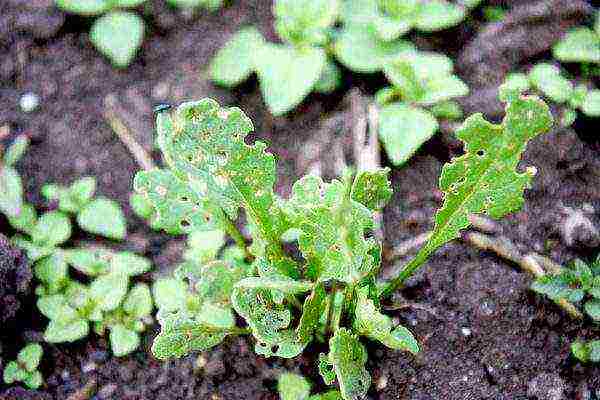
The cruciferous flea is able to almost completely destroy the leaves of daikon seedlings
Prevention remains the most effective way to protect against disease. These are events such as:
- compliance with crop rotation of plants;
- protection of landings from slugs and other pests;
- pre-sowing treatment of seeds in an aquatic environment of contrasting temperatures;
- weeding and loosening, which contribute to aeration of the soil and partial destruction of pests;
- digging the site before sowing and observing all the rules of agricultural technology.
From garden fleas, flies, flower beetles, aphids, bedbugs and fire flies, the plant will be protected by correctly prepared (according to the instructions) solutions of Intavir, Iskra, Alatar, Arrivo, Microcin, Nurel or other pesticides.
Do not neglect antibacterial plants that can be planted in the neighborhood of daikons. These are marigolds, mint, tobacco, basil, rosemary and other crops known for their repellent properties.
Collecting root vegetables
Daikon, planted in summer, is harvested at the end of September - October. Agronomists do not recommend storing root crops in the ground before the onset of frost, since the roots can freeze and subsequently be poorly stored. Sunny warm weather on the day of harvest is also an important factor that will have a positive effect on the shelf life of the root crop.
Cleaning tool - bayonet shovel or pitchfork. They carefully dig in the roots with their subsequent extraction from the ground. Manipulations are carried out very carefully, since the root can go 50-60 cm underground. Mechanical damage to the root crop is undesirable, because they reduce the shelf life and contribute to the occurrence of diseases.
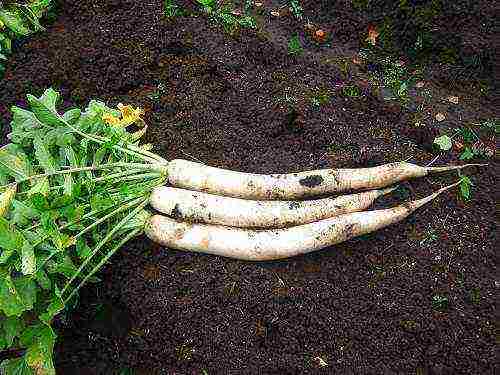
After removing the roots from the ground, they must be allowed to rest and dry right there in the garden
The dug fruits are laid out on the garden bed or in the aisles for 2-3 hours to dry. Then the tops are cut off, and the roots, ready for transportation, are transferred to a permanent storage place. This can be a cool basement, the lower shelf of the refrigerator, a chest in a semi-heated (up to + 5 ° C) utility room. It is recommended to sprinkle the roots with sand before placing them in the chest. For the refrigerator, vegetables can be placed in a paper or canvas bag. Storage in perforated plastic bags is allowed.
Sowing and harvesting dates by region
Depending on the climatic conditions, the sowing and harvesting times of daikon root crops differ.
Table: timing of sowing and harvesting daikon in different regions
Daikon is a vegetable adapted to absolutely any region, climate, soil composition. And for its successful growth, only hardworking hands and seeds are needed, appropriate to the climate.

Winter with daikon on the table will pass unnoticed
Reviews
Vitamin salad on the table every day during the long winter months is quite possible if you are not too lazy to work with a culture like daikon in the summer. There is not a lot of trouble at all, but there will be so much joy from the sensation of the taste of fresh juice that you will want to come up with new combinations of an outlandish root with other vegetables, berries and fruits.
I love a garden, a vegetable garden, flowers.
Daikon (japanese radish) Is a vegetable culture that has recently been gaining popularity among summer residents.
The plant is a subspecies of sowing radish, although, unlike the latter, daikon roots do not contain mustard oils and have a moderate aroma.
There are many varieties of Japanese radish, but in Russia the most famous are:
«Snow White», «Sasha», «Caesar», «Flamingo», «The Dragon», «Big bull», «Elephant fang», «Dubinushka», «Japanese white long».
Daikon varieties
Snow White - early ripening variety. Produces a good harvest both outdoors and in greenhouses. Root crops are white cylindrical in shape, the flesh is slightly sharp, juicy. Stored for up to months. Productivity from 5 to 8 kg / m2.
Big bull - refers to mid-season varieties of Japanese radish. Root crops are large, cylindrical, juicy. Root weight up to 3 kg. Keeping quality good, stored until spring.
The Dragon - mid-season variety. Root crops are cylindrical with a conical transition, smooth. Weight up to 1 kg... The pulp is juicy, tender, white. The taste is sweetish.
Suitable for growing outdoors in summer cottages. The variety is suitable for long-term storage and fresh consumption. The yield is high.
Dubinushka - mid-season daikon variety. Root crops are cylindrical, white, dense, tasty. "Dubinushka" is ideal for growing in protected and open ground in garden plots.Keeping quality is high up to months. Yield up to 10kg / m2... Root crops weighing up to 1.5KG.
Elephant fang - mid-season variety. Cylindrical root crop, white, up to 60 cm... The yield is high, the mass of root crops is up to 0.5KG... The pulp is juicy, white. Suitable for long-term storage and fresh consumption.
Sasha - early ripening variety of Japanese radish, cold-resistant. Root crops are short, cylindrical, smooth, white. The pulp is tender, tasty, juicy. Weight up to 450 g... Resistant to diseases and premature stems. Average yield up to 5kg / m2... Used in any form. The growing season is up to days.
Caesar - mid-season variety. Cylindrical root crops long up to 40 cm... The pulp is white, juicy, reminiscent of the taste of a radish. Recommended for outdoor cultivation. It is consumed fresh, not suitable for long-term storage.
Flamingo - hybrid mid-season variety. Root crops are icicle-shaped even. The pulp is pink, juicy, tasty. Recommended for growing in garden plots for fresh consumption. Yield up to 6 kg / m2, mass up to 1 kg... The variety is resistant to flowering.
Japanese white long - late-ripening variety. Root crops are white, long, weighing up to 3 kg... The pulp is juicy, white, slightly spicy. Differs in good keeping quality and high yield. It won't flab for a long time.
Video - Variety "Dragon"
Share with your friends on social networks

